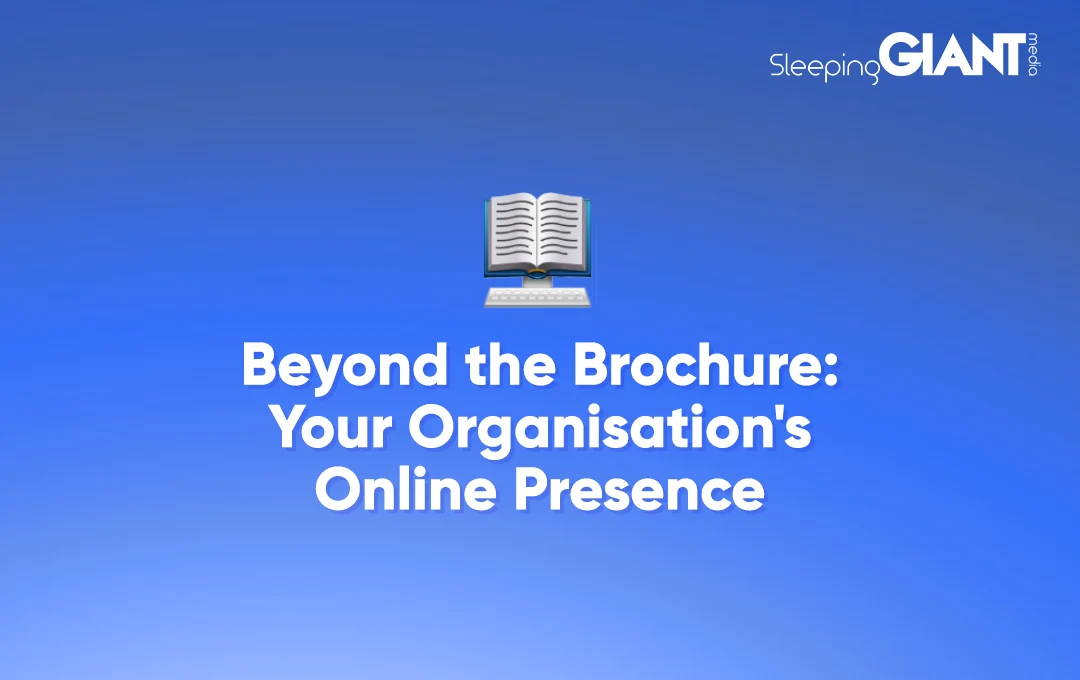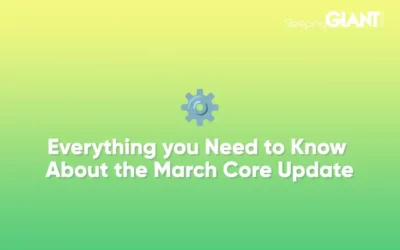
Beyond the Brochure: Your Organisation’s Online Presence
Nowadays, getting in front of the right audience is so much more than just advertising and canvassing. How audiences feel about your organisation’s brand extends so much further than your official brochure.
While physical advertising materials are essential for organisations like schools and charities, maintaining a vivid, authoritative, and accessible online profile is equally crucial for reaching relevant audiences.
You may have been subject to conversations about ‘brand awareness’ and ‘online presence’ — terms that digital marketers love to throw around. But, in terms of actually defining and unpacking these (let’s be frank) pretty brief concepts, little is concretised.
So, if you’re struggling to grasp what online presence actually looks like — especially when it comes to achieving it with an effective digital marketing strategy — read on.
Understanding online presence
Online presence refers to a business or brand’s visibility and representation online. Underneath this broad umbrella term is everything from digital footprint and engagement with users and other organisations online to website material and promotions. Generally speaking, any activity publicly undertaken on the internet by a business feeds into its online presence
‘Presence’ can be good or overwhelming negative depending on factors such as:
- Website quality
- Online content, imagery, and messaging
- Coverage in the press
- Advertisements
- Online discourse with users, customers, and competitors
- Social media posts and profiles
- And so on.
With that being said, there’s a lot at stake here.
Why does it matter?
The stronger your online presence, the greater the chances of your brand reaching and engaging those all-important users.
The concept is simple, if your brand has a positive sentiment associated with it online — and is also strategically positioned in all the right digital places — it is far more likely to see greater footfall from interested users.
SEO & online presence
A strong online presence is also hugely important for SEO (Search Engine Optimisation) purposes. In organic search, Google wants to serve users quality results, typically results that demonstrate high levels of what we call E-E-A-T.
This stands for Experience, Expertise, Authority, and Trustworthiness. Although not an official ranking factor, content and websites that demonstrate E-E-A-T are far more likely to be favoured by Google in search results.
And, if your brand or organisation has a strong, positive online presence, then it is already demonstrating many of the signals of E-E-A-T. This can include:
- Appearing as an expert or authority on a certain topic online
- Featuring in relevant industry publications
- Engaging in online discourse
- Having experience in a certain topic
- Being a trustworthy source of information for users
How to strengthen your online presence
Now let’s learn how to put it all together. The most effective way to strengthen your online presence? A holistic, multi-pronged strategy that doesn’t overlook the basics.
Many companies focus on visibility online, directing plenty of budget into paid advertising to direct users back to their site – without first improving and optimising the site itself. While this seems like the quickest way to draw users in, if you’re sending them to an unoptimised landing page with poor user experiences, the chances are that you’ve wasted your money, as they are highly likely to take one look and bounce right off the page again.
That’s why building an online presence starts with strong foundations — think of it like a house. We need to physically lay rock-solid foundations, walls, and waterproof exteriors if we are to make our guests comfortable. Soft furnishings come last.
Website fundamentals
Technical SEO
Think of technical SEO as the bricks and mortar, without which your online presence would well and truly be built on the sand. Ensuring your organisation or brand’s website is as easy to navigate and well-optimised for user experience as possible is the first thing to do when it comes to online presence.
Here are some guidelines:
- Website speed optimisation. The site should be optimised to load quickly in terms of image size, user browser caching, and code.
- Mobile friendly. Gone are the days when individuals browsed the internet from their family computer. Now, the majority of users are searching from their smartphones — and your site needs to be optimised accordingly, especially since Google uses mobile-first indexing.
- Site structure. Your site needs to be organised logically so that both users and search engines can navigate it. This involves using proper HTML markup, making logical URL structures, and submitting sitemaps like this.
- Schema markup. Using structured data, you should tell search engines what kind of cotton you have on your site by giving them useful context. This helps Google serve your content up to the most relevant searches by users.
- Fixing technical errors. Regular maintenance should also be conducted to make sure that no links are broken or 404 errors are showing.
By focusing on core technical SEO aspects like this, your website has a far greater chance of performing better in organic search, and is far more likely to enjoy higher retention rates from users.
Messaging & content
Once the technical parts are nailed, it is time to think about the content. Your website content is one of the core zones of communication between an organisation and its people (members, potential customers, potential customers, competitors, stakeholders, and so on). So, this content needs to be good. And what does ‘good’ content look like? Use our checklist below:
Accurate & Helpful
- Contains reliable statistics and up-to-date information.
- Free from any spelling or grammatical errors.
- Considers content design to best display the information in a suitable priority order and layout.
- Accessible to all users regardless of ability. This may involve considering colour contrasts, readability, scannability, hidden elements, and alt text for images.
Clear & Informative
- Written in a way that is engaging but also understandable, using images and icons where appropriate.
- Including digestible information that clearly shows what the products or services on offer are.
- Containing plenty of useful links in the form of anchor text to direct users either to supplementary external sources to further their knowledge or to relevant pages on your own site.
E-E-A-T-friendly
- Demonstrating strong levels of authority, with backed-up sources to credible publications.
- Giving an expert’s opinion on the matter at hand.
- Written in a way that exudes confidence and allows readers to trust your brand.
Original
- Free from spam or excessively AI-generated content without human input.
- Channelling your brand and your brand only.
- Giving users a true sense of your organisation’s values, commitments, and qualifications/achievements.
- Unique to the rest of the content on your site and, in fact, the web.
But it’s not just people who have to take on board your site content — search engines do too. This required a deft balancing act between writing for humans and understanding the SEO best practices to make Google favour your site too. This can be done in the form of including helpful internal links, matching your content to the structured data for each page, writing clearly and using semantic triples, and even ensuring that images have correct, useful alt text.
Brand authority enhancement
Once your site is in the best position it can be — a home you’re happy to invite guests back to — you can then begin drawing users in.
This can be in the form of paid advertising across social media platforms or on websites. Or, you may want to run more creative campaigns, such as email marketing or organic social activity.
Another important stream, here, though is brand authority enhancement. As we discussed earlier with E-E-A-T, authority is a crucial factor influencing your organisation’s online performance. But brands often neglect to develop in this area. Using a handful of creative activities, and a little patience, it is easy for your brand to develop authority online.
Digital PR
Digital PR is an excellent way to boost not only brand awareness but also authority. How? By strategically securing media coverage from reputable online sources in your industry. This can take the form of brand mentions, paid partnerships, or even backlinks.
Digital PR activity allows brands to take greater control over their digital perception by circulating selective information to cultivate a positive online reputation. As an added benefit, any mentions and links acquired contribute to improved search engine rankings too!
Content amplification
As part of Digital PR, or on its own, content amplification is another brilliant way to foster a more authoritative online presence.
Writing content, usually blogs or whitepapers, that demonstrates thought leadership and portrays the expertise of your organisation is one thing. Shouting about said content to select circles is another. This can involve sharing your content (often research, studies, statistics, or quotes) on your own social media platforms, or sending it to journalists in the hope of featuring in acclaimed industry publications.
Organic social & interactive content
Lastly, the most direct way to talk to your audiences and develop a personable ‘presence’ online is through the leveraging of organic social media. Here are some best practices that our team of experts recommend when it comes to enhancing how your organisation is seen on socials:
- Ensure your platforms are optimised in line with best practices. You should, for example, fill out all the optional sections ‘about’ your business and include links back to your core webpage.
- Ensure a consistent posting schedule is stuck to. And don’t leave too long between posts, to remain front of mind for your audience.
- Maintain consistency in tone of voice and messaging. Make sure it sounds like you.
- Vary your post types and CTAs (calls to action). You don’t always want to be selling or directing users to fill out Contact Us forms.
- Use optimised assets. Images that are cut off or poorly cropped are sloppy and make your brand look unprofessional. Ensure your images are correctly sized for each platform.
- Tailor the nature of your posts to each platform. LinkedIn is far more professional, while Instagram is much more conversational and image-focused.
- Utilise hashtags #correctly.
- Be personable — that is, develop a unique persona for your brand. This can be humorous like Innocent, or associated with craftsmanship and family like IKEA.
Want your brand to stand out online?
From curating captivating creative campaigns to implementing the technical SEO fundamentals that will give your site the best footing, our team of experts can help your brand stand out from the crowd by leveraging digital marketing activity.
Get in touch with us today to find out how we can enhance your online presence. And, in the meantime, why not dip into our blog or ‘Marketing How To’s’ to keep up with more strategic digital marketing insights?
Blog
Everything you Need to Know About the March Core Update
We knew it wouldn’t be long before Google released their first core update of...
Giant Wednesday
How To Optimise Images For Websites
Digital Marketing, technology & business insights, how-to's and explainer...
Follow Us
Sign Up For More
Stay up to date with the latest happenings, learnings, events & more with our GIANT Newsletters.
Contact Us
Top Floor, The Civic Centre, Castle Hill Avenue, Folkestone CT20 2QY.




